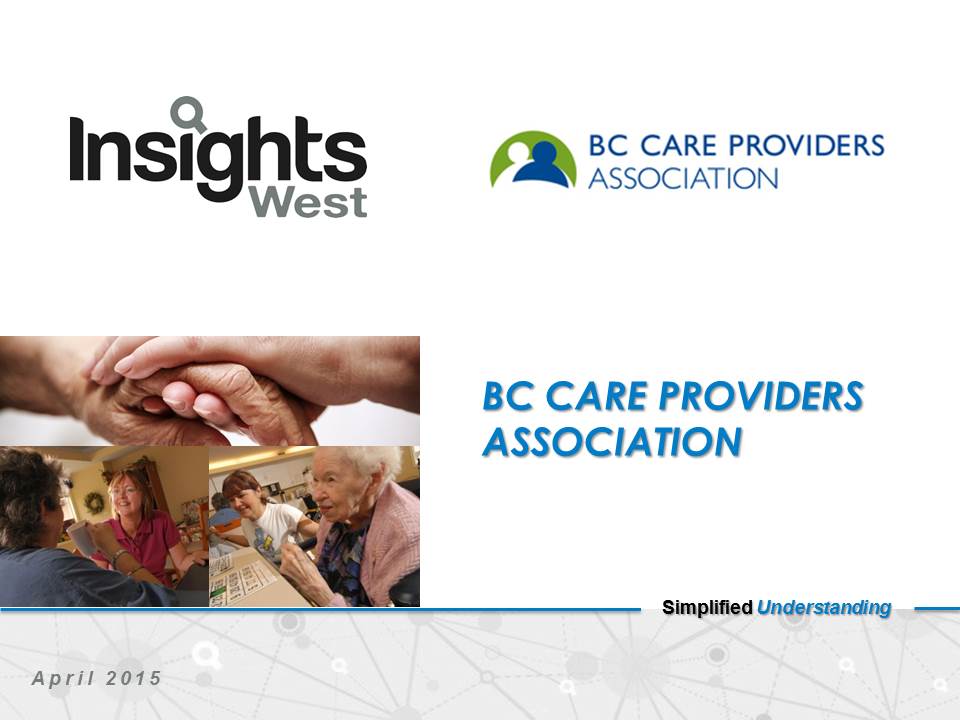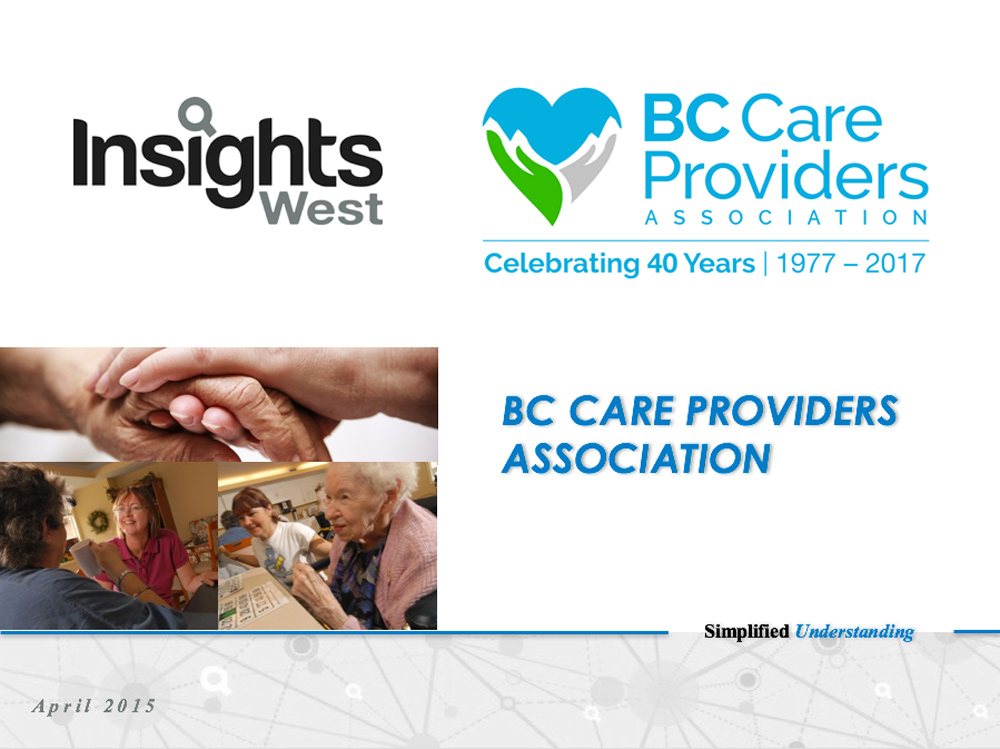
Earlier this year the BC Care Providers Association commissioned Insights West to conduct a province-wide poll providing a glimpse into public opinion on the continuing care sector and seniors care. The poll covered a range of topics including everything from attitudes toward asset testing to perceptions on waitlist times and access to care.
The results included in this presentation are based on an online study conducted from March 25 to March 29, 2015, amond 814 British Columbians aged 18+ who are You Insights panel members. To access the presentation click the image to the right or download it here.
Top 8 Myths and Misconceptions Regarding BC’s Continuing Care Sector
Click here to download this document as a PDF and share it in your workplace.

- Myth: Wait times for residential care in BC have increased or are increasing.
Reality: Although 48% of British Columbians identified that wait times to get access to publicly funded long term residential care services has increased, the median wait time for a senior to access residential care has decreased over the past decade from 1 year in 2001 to currently about 45 days. - Myth: Seniors are more likely to be abused in residential care homes or while receiving care at home.
Reality: Although public perception leans towards increased rates of senior abuse, including almost 40% who believe the number of incidents of financial or physical abuse against seniors has increased over last decade, currently, there is no statistically quantifiable data that can prove this. Care providers, however, do record, investigate and track all incidents of abuse that are reported in their facilities. - Myth: Similar to a hospital setting, most of the food at residential care homes is cooked offsite and brought into care homes each day.
Reality: Although 54% of British Columbians believe food is cooked offsite, the majority of BCCPA members have conveyed that they cook food onsite in a kitchen for their residents. - Myth: There are not enough regulations and government agencies overseeing the continuing care sector.
Reality: Although, 69% of British Columbians agreed that there are not enough regulations, in reality, there are over 100 regulations (including sub-regulations) overseeing residential care facilities in British Columbia. Various regulations included: licensing, facility requirements, staffing, operations and record keeping. BCCPA’s Seniors Care for a Change (2014) highlights, for example, some excessive regulations that, rather than doing their intended job of protecting clients, are instead interfering with care providers’ ability to provide high quality person-centred care. - Myth: The aging population is to blame for uncontrollable healthcare costs.
Reality: Although 85% of British Columbians believe aging is to blame for rising health costs, multiple studies suggest that the impact from aging is modest in comparison to that of other cost drivers, such as inflation and technological innovation. In particular, various studies suggest that growth in healthcare costs due to population aging will be about 1% per year between 2010 and 2036. Studies of clinical data also show that although health care costs are highest when seniors are in the 60-80 year range following that the use of such clinical interventions drops and so do the corresponding costs. - Myth: The average length of stay for seniors in residential care is getting longer as the population ages.
Reality: Although 87% of British Columbians believe the length of stay is getting longer for seniors in care homes, studies suggest that the average length is actually getting shorter. It can be 18 months or less in some care homes. This compares to an average year length of stay of over 4 years in the 1990s. - Myth: Regardless of one’s assets, all seniors should remain eligible for publicly subsidized care services.
Reality: Although 61% of British Columbians disagreed that individuals with net assets over $1 million should remain eligible to receive access to publicly subsidized home care and long-term care residential care services, in most Canadian jurisdictions, including BC, assets are not used to calculate resident contribution rates for care and housing. - Myth: Residential care homes are allocated significant funding by health authorities to provide nutritious meals for seniors on a daily basis.
Reality: Although British Columbians believe care homes are allocated $69 on average to provide meals to residents on a daily basis, the amount allocated by the health authorities for providing meals to residents on a daily basis is about $6 to $7.
Did you also know that …
 91% of British Columbians support the development of a national dementia strategy, which would outline investments in long-term care, including the prevention and early treatment of dementia.
91% of British Columbians support the development of a national dementia strategy, which would outline investments in long-term care, including the prevention and early treatment of dementia.- 82% of British Columbians believe that residents in private long-term residential care homes typically receive different and/or enhanced care.
- 71% of British Columbians believe that they will not have a choice as to which publicly funded care home they want to live in when such care is required.
- 62% of British Columbians believe that the health care system focuses too much on acute care and not on providing ongoing care needs, such as long term care or caring for the chronically ill elderly.
- 78% of British Columbians believe that, assuming the medical condition of the senior is the same, that the total number of funded direct care hours per senior should be the same regardless of which region or care home they live in.
- 68% of British Columbians believe that the government does not provide adequate funding for residential care.
- 54% of British Columbians worry about having enough money to cover future care costs including long-term care.
- 84% of British Columbians believe that as seniors enter residential care facilities with increased acuity or medical complexity, government funding should increase to meet these care needs.
POLL METHODOLOGY: The results included from this poll are based on an online study conducted by Insights West from March 25 to March 29, 2015, among a representative sample of 814 British Columbian adults. The data has been statistically weighted according to Canadian census figures for British Columbia for age, gender and region. Results have a margin of error of ±3.5 percentage points, 19 times out of 20.




